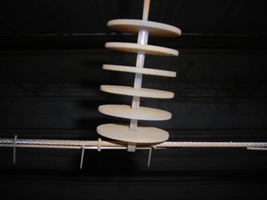Negative ionisation significantly reduces fine dust emission

To be able to comply with European standards on maximum fine dust concentrations in the ambient air, measures need to be taken in the Netherlands to reduce emissions of fine dust from major emission sources.
In view of this, Wageningen UR Livestock Research has set up a plan of action for the development of practical and effective solutions for the reduction of dust emissions from poultry facilities. One of these solutions is the application of negative ionisation of poultry house air.
In the study, the performance of the system was validated on practical broiler farms using a case-control experimental design. At two broiler farm locations, both consisting of two identical broiler houses, one house was equipped with the negative ionisation system, whilst the other house within the same farm location served as a control. In total, four broiler houses were used. Emission measurements were conducted for particulate matter, ammonia, odour and green house gasses.
The aim of this study was to determine the emission reduction of the negative ionisation system according to official measurement protocols and under field conditions. Based on this study, official emission factors can be adopted in legislation and used for environmental permit granting.
At two broiler farm locations with four broiler houses, considerable reduction of emissions have been determined (average ± standard deviation between locations), corrected for an empty period of 18% in case of dust, ammonia, methane and nitrous oxide emissions:
PM10 emission: 22.9 ± 4.6 g/animal place per year for control houses and 11.7 ± 1.9 g/animal place per year for ionization houses
PM2.5 emission: 1.5 ± 0.4 g/animal place per year for control houses and 0.5 ± 0.0 g/animal place per year for ionization houses
Ammonia emission: 47.6 ± 19.4 g/animal place per year for control houses and 57.6 ± 34.1 g/animal place per year for ionization houses
Odour emission (not corrected for empty period): 0.31 ± 0.08 OUE/animal place per second for control houses and 0.27 ± 0.10 OUE/animal place per second for ionization houses
Methane emission: 2.0 ± 0.6 g/animal place per year for control houses and 1.9 ± 1.1 g/animal place per year for ionization houses
Nitrous oxide emission: 2.5 ± 0.8 g/animal place per year for control houses and 2.1 ± 0.4 g/animal place per year for ionization houses
Based on these results, the following emission reductions (ionisation versus control houses; average ± standard deviation between locations) were calculated:
PM10: 48.8 ± 2.3%
PM2.5: 64.9 ± 12.0%
Ammonia: -21.0 ± 24.3%
Odour: 12.2 ± 8.2%
Methane: 5.3 ± 24.4%
Nitrous oxide: 15.9 ± 13.2%
Source: WUR Report nr 462












